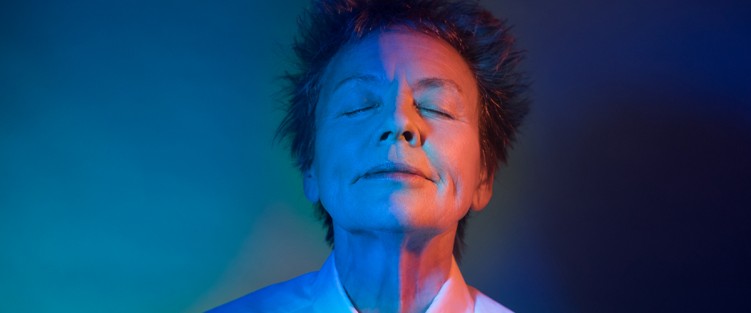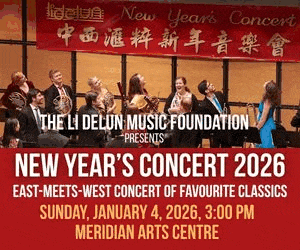 Trying to capture in words my experience of Laurie Anderson’s performance at Koerner Hall on January 18 is almost an impossibility. There was music of course, along with Anderson’s distinctive approach to storytelling, but the entire evening flowed like a dream, from one scene or emotional tone to another. Hopefully some of that can be communicated through the printed page or screen, but I highly recommend listening to her most recent album release, entitled Songs from the Bardo, to fill in some of the sonic gaps.
Trying to capture in words my experience of Laurie Anderson’s performance at Koerner Hall on January 18 is almost an impossibility. There was music of course, along with Anderson’s distinctive approach to storytelling, but the entire evening flowed like a dream, from one scene or emotional tone to another. Hopefully some of that can be communicated through the printed page or screen, but I highly recommend listening to her most recent album release, entitled Songs from the Bardo, to fill in some of the sonic gaps.
When I interviewed Anderson for the story that appeared in The WholeNote’s December/January edition, I asked her to tell me about her new work The Art of Falling that we would hear in her 21C Festival performance. Her response aroused my curiosity: “I don’t know to what extent it will be a brand-new work or to what extent it will be a collection of things.” She described her work as looking back and forward at the same time, and that “it might be something like that, or it might go another direction too.” She did know, however, that it would be a collaborative improvisation with cellist Rubin Kodheli in which she wanted to leave lots of room for things to evolve and “go off the track a little.” My interest was sparked and I couldn’t wait to hear what she would bring to the stage.
As soon as the pair walked onto the stage on January 18, they entered into a musical duo full of pulsating rhythms and repetitive musical gestures, opening up the space for what was to come. Anderson then walked over to the opposite side of the stage to begin telling the first story sequence of the evening, describing various scenes of environmental degradation: burning forests and melting ice. “Am I just dreaming or is this real?” she asked. Moving in a seamless progression, she began to talk about politics in the United States, describing how we end up voting for the person whose story we like the most or feel is the most true. She described the quiet on the streets of New York the night after Trump was elected, and Yoko Ono’s response: tweeting a 19-second long scream. From there she invited the audience to join together and create a collective scream. We were encouraged to imagine similar scenes of environmental destruction and then scream. “Give it your all,” she encouraged. And we did. It was a harrowing moment, but also finally a relief – that collectively we could hear ourselves expressing something that too often we keep below the surface. Later on in the performance, she pointed out that we are the first humans to have to tell the story of possible human extinction and that this is a story nobody wants to hear. The group scream was followed by an instrumental improvisation characterized by aggressive and dense textures created from her technical setup of loops and pre-recorded tracks.
During the storytelling sequences, Anderson alternated between accompanying herself at the keyboard, sometimes using her vocoder to transpose her voice into a low register, and delivering the text standing or sitting at a microphone in other stage locations. The stories were always told floating on top of a drone-like musical texture made up of repetitive sequences, often alongside musical commentary and interjections from Kodheli’s exquisite cello playing. This enabled the performance to move without interruption and created the sense that we were floating along deeper and deeper into a more timeless state of awareness, like birds flying in endless circles in the sky. It was a perfect environment that eventually brought us into Andrson’s presentation of an ancient Greek comedy entitled The Birds (written by the playwright Aristophanes). And in her characteristic humorous style, Anderson set it all up by referencing the dream of the building of a wall by a certain current American politician. In the Greek play, the character Pisthetaerus convinces the birds to create a city in the sky so that they could regain their original god-like status and keep out those they didn’t want to enter. The contemporary parallels were stunningly obvious. As the music shifted into a lament, Anderson began listing the loss of various species, ending with the potential loss of humanity. What would John Cage say? “Listen,” was her response.
She then took the audience into one of the more remarkable experiences I’ve had in a concert: a guided hypnotic journey designed to create a deep inner state of consciousness. She used various devices, such as imagining the central core of our brain or feeling the similarity between the temperature in the room and our skin. We were to enter each new image on vocal instruction: “I say ONE”. The music grew in intensity and density during this experience, and I can’t quite recall when things shifted again and we were back into a different sea of images: how Jackie Kennedy faked smiling, Anderson’s personal loss of valuable archives and artworks during Hurricane Sandy. She listed various things that we can lose: looks, reputation, Facebook friends, civility, democracy. Her biggest loss, she then told us, was the loss of husband Lou Reed, a person who understood energy more than anyone else she knew. As the music shifted here into a lush stringed orchestra sound that could have been sampled sounds of the Japanese koto or the Chinese Guzheng, Anderson moved to centre stage and performed a stunning sequence of Tai Chi movements.
As the work grew to a close, we were taken once again into readings from the Tibetan Book of the Dead, no doubt drawn from her album Songs From The Bardo (as she hinted at during our earlier interview). The Bardo is that place after death where our consciousness travels to and where we experience a change in the state of our energy. As the musical textures soared, all I can say is that I felt a glimmer of that place – the immensity, grandeur and power that resides there.
The following evening on January 19, there was a screening at the Ted Rogers Hot Docs Cinema of her film Heart of a Dog, which also referenced themes of death, loss and transition. During the Q&A afterwards, Anderson was asked about these transitions we go through in the Bardo. She replied: “Everything is a transition. Music is always moving in a state of flux. We are in the Bardo now. We are the ones asleep. The dead are awake.”
Anderson’s more recent explorations into approaching performance as an improvisation – as we experienced it in The Art of Falling – have created a more expansive and visceral atmosphere in her work, a way of being “open and free rather than carving out what will happen,” as she expressed during the January 19 Q&A. She summarized her approach in this way – that she is attempting to “push things together and use the opportunity to bring teachings from my teacher.” From such a simple stance, holy elegance was the result.
Laurie Anderson presented The Art of Falling at the RCM’s 21C Festival, on January 18, 2020.
Wendalyn Bartley is a Toronto-based composer and electro-vocal sound artist. sounddreaming@gmail.com.


